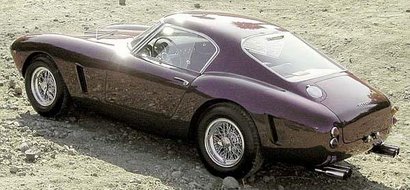Here is the first part of a series that I have been writing over the past couple of weeks. I expect that some of the content may be disputed or even controversial, so be it - I await comments, criticism etc. as usual. I also await your custom!
Fulvia Engine Developments
Part I
Background and General Considerations
 Gas-flowing: the early stages
Gas-flowing: the early stagesOver the years, I have been asked many times about increasing the power output from the Fulvia engine. I usually point out that there is no simple route, for reasons I shall try to explain later in this series of articles.
In fact in standard form, the Fulvia was remarkably powerful in its time – that is in specific terms, with roughly 70 hp per litre; few of the Fulvia’s contemporaries could boast such efficiency. I well recall my amazement when, driving with two friends in my first 1300 S2 coupe at 100 mph, I was able to converse without shouting! I sometimes think that for those who use their Fulvias only as road cars, pursuit of extra power is rather pointless. After all, the process is very labour-intensive and consequently expensive and naturally the car’s character will change. I have also observed that efforts to improve the driver’s performance could be cheaper and more effective; a Fulvia in the right hands is still quick today from A to B. And as standard and in good order, it is a lovely car.
Nevertheless, there are always those who wish to develop the car either for the sheer hell of it or for competition purposes and it is these to whom this article – or rather, series of articles – is addressed.
**************************
Before examining the Fulvia I would ask you to consider the engine in the old Mini. Here we have a cast-iron motor that can trace its origins back to about 1948 or perhaps even pre-war. It has vertical valves side-by-side in its cast-iron head, long push rods, long stroke (except for the 970 and 1071 “S” cars) two siamesed inlet ports and three exhaust ports, with cylinders 2 and 3 having to share the middle port. Read any engine theory book and you will see that theoretically this recipe is hardly promising. Despite this, a number of tuners have obtained more than 100hp/litre from this engine in various sizes, running at around 8000 rpm and this was some years ago; they are probably doing even better now.
Very well, let’s consider the Fulvia’s engine: short stroke, twin overhead camshafts, valves inclined at 60 degrees included angle, light valve gear, nicely shaped combustion chambers (similar to Porsche 911) one carburettor choke per cylinder, aluminium cylinder head, high compression and so on. And unlike so many production engines, there is a fully counter-balanced steel crankshaft, forged rods and rockers etc. One could be forgiven for thinking that the sky’s the limit. Sadly this appears not to be so. Here are some horsepower figures:
Works Gr IV 1600 Rally car 1972/3: 1599* cc – 158hp
Special prototype 1300 engine – 143hp†
*Works cars were generally bored to 82.4mm
† Quoted in “Lancia Racing” by Nigel Trow
I should add that I have been told by someone who claimed to have seen the factory papers that in fact Lancia never got more than 150hp from their 1600cc rally cars. And I am sure that the special 1300 engine mentioned above was very much a one-off. And the same source told me that he had it on good authority that quite frequently at the factory in the old days there would be an explosion from the test house quickly followed by a number of excited Italians running out… The problems of trying to get big power from a Fulvia…
Two more Fulvia examples:
1300 Sport Competizione (owned by Carlo Stella)
This car was extensively developed in 1972 by Baggioli and Gottfredi and is fitted with Kugelfischer fuel-injection (See Stella’s book on the Competiziones).
It develops “around 144hp” at 8500 rpm (111 hp/litre)
Finally, my own car developed with no money of course!
1599cc, 11.5/1 compression, special camshafts, big valves, Lucas fuel-injection, special exhaust etc.; about 145-150hp at 6700rpm (90.6 – 93.8hp/litre). I should add it would probably be a bit better if I had the time and money to calibrate the injection, make a new exhaust system etc.
I mentioned the Mini engine above; here’s another period competitor:
A very powerful FIAT 128 engine with Kugelfischer injection
Source: “FIAT 128 La Storia etc.” pub. Sileagrafiche
FIAT 128. 1300 c.c. single overhead camshaft, wedge-shaped combustion chambers, cylinder dimensions 86 x 55mm. Italian tuners such as Trivellato extracted up to 160hp (123 hp/litre) from this engine, which would run at 9,000 rpm with its standard cast-iron crankshaft and over 10,000 with a steel one. Incidentally at high revs they sound glorious!
*******************
Next time: A detailed look at some of the limiting factors (from a developmental point of view) of the Fulvia design













No comments:
Post a Comment